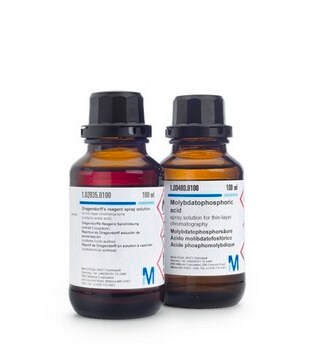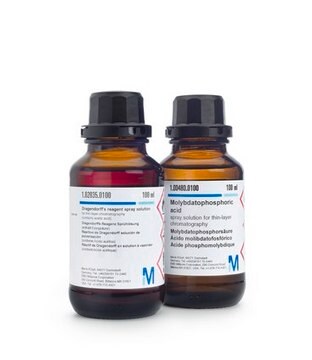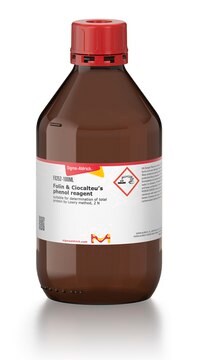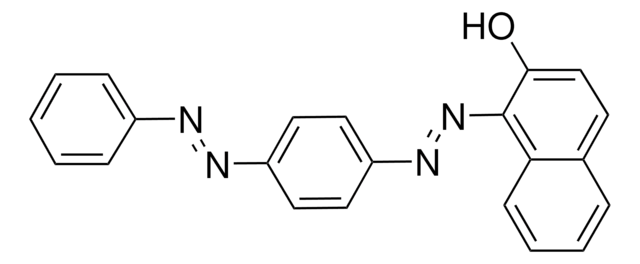44578
Dragendorff reagent
for TLC derivatization
About This Item
Productos recomendados
grado
for TLC derivatization
Nivel de calidad
composición
acetic acid
ethyl acetate
sodium iodide
sodium tetraiodobismutate
técnicas
thin layer chromatography (TLC): suitable
InChI
1S/Bi.4HI.K/h;4*1H;/q+3;;;;;+1/p-4
Clave InChI
ONBIUAZBGHXJDM-UHFFFAOYSA-J
Aplicación
- Nematocidal alkaloids from the roots of Stemona mairei: This study explores the use of Dragendorff reagent for the identification of nematocidal alkaloids, demonstrating its critical role in the pharmacological profiling and characterization of natural products (Shi et al., 2023).
- Rapid Detection and Determination of Scopolamine in Black Henbane: Leveraging Dragendorff reagent, this research developed a novel nanosensor for detecting scopolamine, an important application in pharmaceutical analysis and toxicology (Mousavizadeh et al., 2022).
- Proximate analysis and multi spectrometric analysis of Strychnos nux-vomica nuts: The use of Dragendorff reagent in the multi-spectrometric analysis highlights its versatility in chemical synthesis and compound identification, providing essential insights for medicinal chemistry (Ramachandran et al., 2022).
- TLC-MS identification of alkaloids in Leonuri Herba and Leonuri Fructus: This study used Dragendorff reagent to optimize a universal derivatization method, enhancing the detection and analysis of key pharmaceutical compounds in traditional medicine (Zhang et al., 2021).
- Densitometric TLC analysis for control of tropane and steroidal alkaloids in Lycium barbarum: Demonstrates the application of Dragendorff reagent in food chemistry for ensuring the safety and efficacy of herbal supplements through the precise detection of alkaloids (Kokotkiewicz et al., 2017).
Otras notas
Palabra de señalización
Danger
Frases de peligro
Consejos de prudencia
Clasificaciones de peligro
Eye Dam. 1 - Flam. Liq. 2 - Skin Corr. 1B - STOT SE 3
Órganos de actuación
Central nervous system
Código de clase de almacenamiento
3 - Flammable liquids
Clase de riesgo para el agua (WGK)
WGK 3
Punto de inflamabilidad (°F)
44.6 °F
Punto de inflamabilidad (°C)
7 °C
Equipo de protección personal
Faceshields, Gloves, Goggles, type ABEK (EN14387) respirator filter
Elija entre una de las versiones más recientes:
Certificados de análisis (COA)
¿No ve la versión correcta?
Si necesita una versión concreta, puede buscar un certificado específico por el número de lote.
¿Ya tiene este producto?
Encuentre la documentación para los productos que ha comprado recientemente en la Biblioteca de documentos.
Los clientes también vieron
Nuestro equipo de científicos tiene experiencia en todas las áreas de investigación: Ciencias de la vida, Ciencia de los materiales, Síntesis química, Cromatografía, Analítica y muchas otras.
Póngase en contacto con el Servicio técnico













